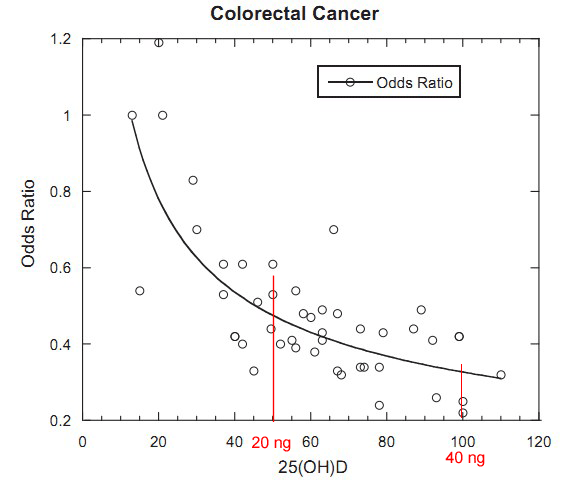Colon cancer 23 percent less likely if vitamin D levels higher than 30 ng
Association between circulating concentrations of 25(OH)D and colorectal adenoma: a pooled analysis.
Int J Cancer. 2013 Dec 15;133(12):2980-8. doi: 10.1002/ijc.28316. Epub 2013 Jul 11.
Elizabeth T. Jacobs 1,2,*, Elizabeth A. Hibler 1,2, Peter Lance 1, Christine L. Sardo 2,
Peter W. Jurutka 3,4
1 University of Arizona Cancer Center, University of Arizona, Tucson, Arizona
2 Division of Epidemiology, Mel and Enid Zuckerman College of Public Health, University of Arizona, Tucson, Arizona
3 School of Mathematical and Natural Sciences, Arizona State University, Phoenix, Arizona
4 Department of Basic Medical Sciences, The University of Arizona, College of Medicine, Phoenix, AZ
- Correspondence to: Elizabeth T. Jacobs, University of Arizona Cancer Center, 1515 N. Campbell Ave, Tucson, AZ 85724-5024, USA, Tel.: 520-626-0341, Fax: +520-626-9275, E-mail: jacobse@email.arizona.edu
The relationship between the biomarker of vitamin D status, 25(OH)D, and the risk for colorectal neoplasia is suggestive but equivocal. Questions remain regarding whether there are differential associations between 25(OH)D and colorectal adenoma by gender, colorectal subsite or features of baseline and recurrent adenomas. We sought to investigate the relationship between 25(OH)D and both baseline and recurrent adenoma characteristics. Our study was conducted among 2,074 participants in a pooled population of two clinical intervention trials of colorectal adenoma recurrence. A cross-sectional analysis of 25(OH)D and baseline adenoma characteristics and a prospective study of recurrent adenomas and their characteristics were conducted. There was a statistically significant inverse association between the concentrations of 25(OH)D and the presence of three or more adenomas at baseline.
Compared to participants with 25(OH)D levels of <20 ng/mL, the adjusted odds ratios (ORs) (95% condifdence intervals [CIs]) were 0.99 (0.70-1.41) for those with concentrations of ≥20 and <30 ng/mL, and 0.73 (0.50-1.06) among participants with levels of ≥30 ng/mL (p-trend = 0.05). Baseline villous histology was also significantly inversely related to 25(OH)D levels (p-trend = 0.04). Conversely, 25(OH)D concentrations were not associated with overall colorectal adenoma recurrence, with ORs (95% CIs) of 0.91 (0.71-1.17) and 0.95 (0.73-1.24; p-trend = 0.85). These findings support the concept that the relationship between vitamin D and colorectal neoplasia may vary by stage of adenoma development.
Copyright © 2013 UICC. PMID: 23754630
---\
See also VitaminDWiki
- Overview Cancer-Colon and vitamin D which has the following chart

